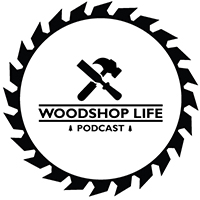Support us on Patreon: https://www.patreon.com/woodshoplife
Questions
Guys
1) I would like to have a better understanding of what is safe and what isn’t when cross cutting on the table saw.
I have seen lots of videos and read lots of articles that mention how dangerous cross cutting on the table saw can be when the aspect ratio of the work is such that the distance between the blade and the fence exceeds the length of the edge that is against the fence. This makes perfect sense to me as you want to avoid the possibility of the work twisting between the blade and fence and kicking back.
However, there are countless videos of supposedly knowledgeable woodworkers breaking down sheet goods and violating this aspect ratio rule. Do these rules not really apply when breaking down sheet goods for some reason?
2) Hello, I just picked up a Incra Ls positioner fence at a yard sale for $20, (they didn’t know what it was). My question is when do you choose to use the Incra verses using your dovetail jig? I don’t currently have a dovetail jig, are there some situations where a dovetail jig would be better? Any general discussion on the Incra would be great. Thanks, keep up the good work, the podcast has been excellent! – Travis
Seans
1) This is a router operation question. I was recently making a new jig for a project that required that I cut a long slot all the way through a piece that would allow a bolt to slide along that piece. (The piece is 16 by 2 and is about 5/4 thick. I was cutting a 1/4 slot that ran in the middle of the piece for about 15 inches. It would allow bolts to pass through the piece and then it could slide along the bolts so that it’s position can be adjusted. Hope that makes sense)
I was using a 1/4 inch straight cutting bit in a router and making the cut in multiple passes. I had the cutting speed set relatively high (somewhere around 20,000 – 24,000 RPM) and was going about an 1/8 deep per pass. I was using a cheap bit so I was running in shallower passes than I would have thought necessary knowing that the performance of the bit is probably going to be lacking. Despite my best efforts the bit snapped off…Luckily it stayed in the groove I was cutting and did not become a projectile and there was no damage to the tool or the piece.
The situation raised a few questions for me:
1. How deep would you plunge that size a bit and expect it to cut without any safety or performance concerns? (my piece was laminated baltic birch ply if the material makes a difference. Bit was a 1/4 inch, 1/4 shank straight cutting bit.)
2. Is there something I should be doing in this type of situation to prevent this outcome? I had inserted the bit fully into the collet, I had set it to what I thought was an appropriate speed for it’s size and I went shallow with my cuts not to stress it too much. Did I do the right things there? Other than getting a better bit, what would you do differently?
2) Hi Guys,
My question is about Joiner fences. I picked up an old 6″ Delta Shop Master a few years that was in great condition, except that the fence on the outfeed side is welded to the table. I’ve never had the need to change the fence’s angle (it’s welded and calibrated to 90°) but I could see adjusting it’s depth to reduce wear on my straight blades.
Do you guys find your self moving the fence often, or at all and if so, why?
Thanks for sharing your expertise and furthering our craft! Justin
Huys
1) Ahoy fellas. Absolutely love the podcast, been listening for a long time… BUT first time question for you.
Router Slab jigs. I’m getting ready to do an epoxy table and have seen plenty of “how to” videos on building your own on the Tube of You. But none of them explain how to set them up. What exactly needs to be parallel? Do I need a perfectly flat surface to set my piece on or no? I’m guessing as long as I shim my workpiece, I’ll be fine. But then do I also have to make sure the piece is roughly on the same plane as the rails?
Overall my main worry is getting finished and I have one side of my table thinner than the other.
What am I missing?
Appreciate it! Keep up the GREAT work. Paul
2) Gonna keep this one simple. What is your favorite style of furniture to you enjoy building? Second part, what is your favorite period of furniture if it differs from what you enjoy building?
Thank you for your time and please keep up the absolutely wonderful work y’all are doing on the podcast and your shops! The information y’all share is always spot on!
Thanks,
Brent Jarvis
Clean Cut Woodworking
Social Media Mentions
Sean: @christopherscottfurniture
Guy: @Karlholm.design
